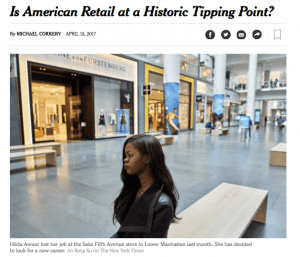
Mark Cohen, who runs the retail studies program at Columbia Business School, said a “sea change” is afoot in retail.
Customers’ love of e-commerce has changed the modern retail environment — and the shift for some brick-and-mortar businesses, particularly in suburban malls, is only accelerating.
“Modern-day retail is becoming unrecognizable from the glory era of the department store in the years after World War II,” writes Michael Corkery for The New York Times. “In that period, newly built highways shuttling people to and from the suburbs eventually gave rise to shopping malls — big, convenient, climate-controlled monuments to consumerism with lots of parking.”
Between 2010 and 2014, however, he adds “e-commerce grew by an average of $30 billion annually. Over the past three years, average annual growth has increased to $40 billion.”
“That is the tipping point, right there,” said Barbara Denham, a senior economist at Reis, a real estate data and analytics firm. “It’s like the Doppler effect. The change is coming at you so fast, it feels like it is accelerating.”
According to Corkery’s reporting, about 89,000 Americans have lost jobs in general merchandise stores since October. “The job losses in retail could have unexpected social and political consequences,” he explains, “as huge numbers of low-wage retail employees become economically unhinged, just as manufacturing workers did in recent decades.”
About one out of every 10 Americans works in retail.
“There is a sea change happening in the retail industry,” said Mark Cohen, a former executive at Sears, who now runs the retail studies program at Columbia Business School. “And that is bringing a sea change in employment.”

